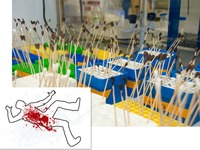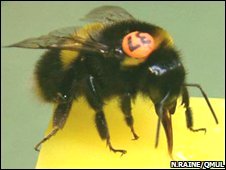The scene at the nursing home is grim. An elderly man lies in a pool of blood on the floor of his bedroom. Detectives also find blood from an unknown individual near the door, suggesting the victim put up a fight. Was the assailant one of the octogenarian’s fellow residents, or perhaps a nurse or an orderly? The detectives have little to go on until analysis of the unknown blood reveals it came from someone in their 20s or 30s.
That’s a fictional scenario—for now. But researchers report online today in Current Biologythat they can estimate someone’s age—give or take about a decade—simply by analyzing a drop of blood. If validated, the new forensic technique could revive police investigations that have hit a dead end.
The blood-age test relies on a peculiarity of T cells, immune cells that recognize and fight microbial invaders. As a T cell develops, it cuts up some of its DNA and splices some of it back together in various combinations; that helps it generate unique cell-surface receptors that can recognize a wide variety of bacteria or other pathogens. Any leftover DNA forms a circle that is useless to the T cell.
Researchers can quantify how many circles exist in the blood, says Manfred Kayser, a forensic molecular biologist at Erasmus University Medical Centre in Rotterdam. He and his colleagues have found that the amount declines with age because the body produces fewer and fewer new T cells as people get older. “We take advantage of this waste product,” he says.
The researchers established the promise of the forensic technique by analyzing the blood samples of about 200 people varying in age from a few weeks old to 80 years old. They probed the samples with fluorescent DNA designed to bind to the excess T cell DNA fragments, allowing them to quantify those fragments in a matter of hours. The team found a correlation between the number of T cell DNA fragments and age, one strong enough to pinpoint how old a person was, plus or minus 9 years.
That may seem like a big range, but it’s enough to place suspects into generational categories, which is very helpful to police, says Peter de Knijff, head of the forensic laboratory at Leiden University Medical Center in the Netherlands. Right now, law enforcement officials armed with a blood sample can identify its owner only if they can match it to a known suspect, or if it matches DNA in a database. With this new test, and a test for eye color, also developed in Kayser’s lab, de Knijff says that at least police can narrow down their suspect pool. “This is the best we have right now.”
Kayser says that he hopes to make the T cell test more accurate by combining it with other aging biomarkers that his team is developing. He also notes that the T cell test was still accurate on blood collected a year and a half earlier. That means it could be used to resolve cold cases as well as help police identify disaster victims.
Before the technique becomes widely available to forensic teams in the Netherlands, it will need to be verified by two independent labs, says de Knijff. There are calls for this test already, he adds, in cases where the trail has gone cold and new evidence is desperately needed.
:: Read original here::

 The way bumblebees search for food could help detectives hunt down serial killers, scientists believe.
The way bumblebees search for food could help detectives hunt down serial killers, scientists believe.